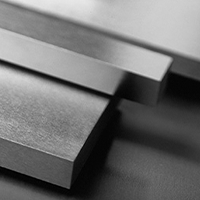Select Your Steel Grade
What is Tool Steel?
Tool steel (DIN EN ISO 4957) is being used to produce cutting tools, molds or forming tools. It can be categorized, by application, into unalloyed, low alloyed and high alloyed tool steels. High alloyed tool steel crosses fluidly over to “stainless steel” (corrosion resistant steel). Tool steel has a carbon content up to 2.1% and it can be divided further by its quenching methods as an oil, air and water hardening steel as well as its applications as a cold work, hot work steel and high speed steel (HSS).
Cold work steel is tool steel that can be used for applications where the surface temperature of the cutting edge does not exceed 392°F. They can be, due to their alloys, have a high through hardenability, polishability, wear resistance and ductility. They find their use in for example cold rolling, machining, and guiding.
Hot work steel can be used for tools which can be used at temperatures up to 752°F. They find their uses for applications such as press punches, die casting molds and dies as they have properties such as high creep resistance, high temperature toughness or heat wear resistance.
High speed steel: The definition and explanation can be found in a separate document/article.
What is unalloyed tool steel?
Unalloyed tool steel, also known as carbon steel, has a carbon content of 0.5-1.5% and does not have any other added alloys apart from natural components found in iron like sulphur, manganese, or phosphorus. It is possible with a combined heat treatment to quench and temper (QT) the chosen steel grade, which means that the surface hardness, depending on the carbon content, can be drastically increased.
Unalloyed tool steels are cold work steels for an operating temperature of up to 392°F. They can be hardened through but also have a high surface hardness, high wear resistance and good cutting capabilities.
Unalloyed tool steel can be used to produce simple tools which are subjected to low stress.
Unalloyed tool steels can be further divided into low carbon content, approx. 0.05-0.24% (Steel 1018 / A36), medium carbon content, approx. 0.25-0.6% (Steel 1045), high carbon content, approx. 0.60-1.00% (Steel W1) and very high carbon content, approx. 1.00-1.5%.
What is alloy tool steel?
Alloy tool steel specifies steel which contains not only iron (Fe) and carbon (C) but further alloying elements in sufficient quantities to change the properties of the base material. Adding for example chromium, silicon nickel, manganese, molybdenum, or vanadium, with a total alloying content of a mass fraction of 5%, properties such as ductility, creep resistance or tempering resistance can be influenced.
Alloy tool steel can be cold work steels but as well hot work steels for a working temperature up to 752°F (the exception is the 2990 mod., as a cold steel it can be used up to 932°F). High speed steel is being used for working temperatures up to 1112°F.
Unlike unalloyed tool steel alloyed tool steel can be hardened through. For that process they will be heated and then quenched in oil, air, or water. Alloyed tool steel can be used to produce tools that are exposed to higher stresses as they have a higher creep resistance, higher hardness, and higher tempering resistance.
What are high alloy tool steels?
High alloy tool steel, like D2 – 153CrMov12, as well as high speed steels are being used for tools that are exposed to extreme stresses. They have a carbon content of up to 2.1% and contain other alloying elements with a mass fraction between 6% and 30%. Some high alloy steels can be used at a working temperature up to 1112°F and have at least one of the following properties, good machinability, high ductility, high wear resistance or high working hardness.
Search for an alternative Tool Steel with the ABRAMS STEEL GUIDE®!
All orange highlighted tiles show tool steel with an array of properties.
Just one click to your chosen steel grade with its properties.
It is possible to find an alternative or an equivalent steel grade in no time at all!
We have the solution! (Registration is not needed).
Try it now - find an alternative steel grade and its properties in no time.


